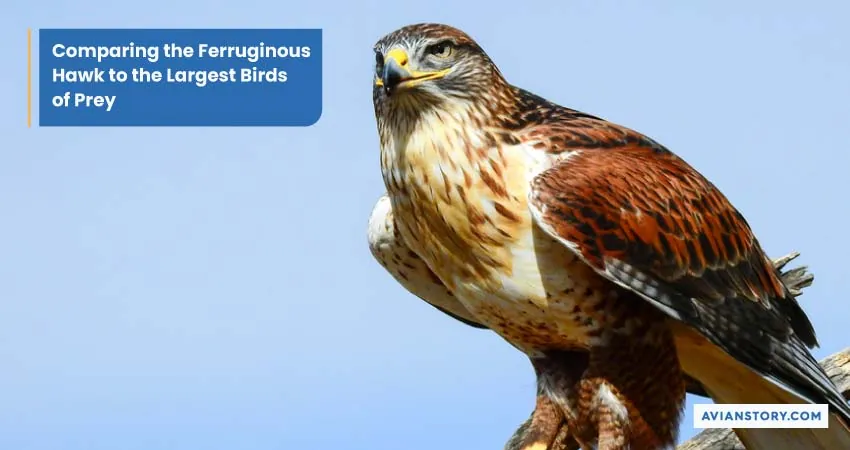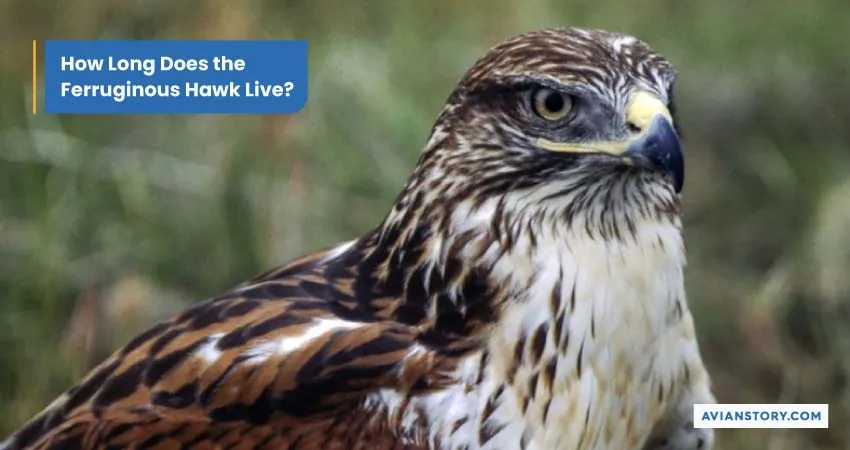Largest Hawk In The World (Exploring the Ferruginous Hawk)
The Ferruginous Hawk (Buteo regalis), with its imposing stature and majestic presence, is an amazing addition to nature’s beauty. Being the largest hawk in the world is not the only thing that’s special about them.
The hawk’s captivating plumage and exceptional behavioral characteristics also set it apart from other similar species. Considering the importance of Ferruginous Hawks in biodiversity, we must know more about them to facilitate effective conservation efforts and biodiversity preservation.
Also, understanding this inspires a deeper appreciation for the natural world. In this article, we are going to explore some amazing Ferruginous hawk facts and, additionally, information that will help us appreciate them more.
What Is the Largest Hawk in the World? Physical Characteristics

The title “world’s largest hawk” already informs us that the Ferruginous Hawk’s size is the largest. But how big is it? How do you distinguish a Ferruginous Hawk? Let’s check out.
Size and Weight
The Ferruginous Hawk, scientifically known as “Buteo regalis,” has a wingspan of up to 56 inches (142 cm) and a length of 27 inches (69 cm). On average, adult Ferruginous Hawks typically weigh between 2.2 and 4.7 pounds. Additionally, female ones tend to be larger and heavier than males, with weights of up to 5.8 pounds.
Feather Coloration and Patterns
Its feather coloration is reddish chocolate. Below are the highlighted plumage patterns:
- Rusty brown upper parts
- White breasts
- A pale head with a dark checkmark
- A pale tail with dark bars
Beak and Claw Description
They use their hard and curved beaks to tear into their prey effectively. Its sharp and curved talons or claws are well-adapted for grasping and capturing prey.
Unique Features
Finally, this hawk’s feet and legs are covered in feathers, which is a distinctive feature among raptors. Another excellent hawk identification would be its dark-colored beak that is hooked at the tip.
Table: Comparison In Size Of Ferruginous Hawk With Others
We have claimed that the Ferruginous Hawk is the largest hawk in the world. Here, we are going to prove this walk fact by using comparisons with other well-known large avians.
| Hawk Species | Body Length in inches | Wingspan in inches |
| Ferruginous Hawk (Buteo regalis) | 25-27 | 53-56 |
| Red-tailed Hawk (Buteo jamaicensis) | 17-27 | 41-56 |
| Swainson’s Hawk (Buteo swainsoni) | 15-24 | 46-54 |
| Cooper’s Hawk (Accipiter cooperii) | 13-21 | 29-37 |
Comparing the Ferruginous Hawk to the Largest Birds of Prey

The Ferruginous Hawk is certainly the largest when it comes to Hawks. But in consideration of all the birds, it is not the largest one of prey. For instance, here we have compared this hawk with the largest bird of prey: the Andean Condor (Vultur gryphus).
| Comparing Sides | Ferruginous Hawk | Andean Condor |
| Size | 22-27 inches in length | 46-53 inches in length |
| Weight | Weigh between 2.2 to 4.7 pounds | Wigh 20 – 30 pounds |
| Eating Habit | Carnivorous | Scavenger |
| Lifespan | Approximately 20 years | Approximately 50 years |
| Habitat | Grassland, shrub steppe, etc. | Rocky cliff, coastal area, etc. |
Well, with having differential characteristics from the Andean Condor, Ferruginous Hawks also can be differentiated from other larger raptors. In comparison to other raptors’ predatory traits, there are two unique things we would like to mention here.
- Firstly, unlike many hawks, it has a feathered tarsus. This adaptation provides the hawk additional insulation in cold environments.
- Secondly, Ferruginous Hawk’s nests are large, and they reuse the nest.
Geographical Range and Habitat of the Ferruginous Hawk

The Ferruginous Hawk is found exclusively in North America, ranging from the southwestern regions of Canada and across the Western United States. It also can be found in northern Mexico.
While grasslands and prairies are its preferred habitats, the Ferruginous Hawk can also adapt to other environments. It can be found in agricultural lands, rangelands, and even lightly wooded areas.
On the other hand, nesting sites for the Ferruginous Hawk typically consist of large trees, cliffs, rock outcrops, shallow canyons, etc. Like other hawks, they prefer nesting sites that are located in relatively undisturbed areas that are away from human activity. And in most cases, their nests are located alongside the waterways.
The table below is meant to help you understand the factors for Ferruginous Hawk’s habitat preference.
| Factors | Explanation |
| Prey Availability | The open grasslands and prairies support abundant populations of prey species like rabbits, squirrels, gophers, rats, etc. These species are the prime food source for the hawk and its offspring. |
| Visibility and hunting efficiency | The sparse vegetation in grasslands and prairies allows the hawk to have excellent visibility. This assists the hawk in spotting and tracking prey from a high location. |
| Flight and soaring opportunities | The open habitats provide ample space for the Ferruginous Hawk to engage in its characteristic soaring flight. Also, the respective vast open-air condition is empowered by thermal updrafts and air currents. These airflow assist the hawk in gliding effortlessly and conserve energy while searching for prey. |
| Nesting site availability | The open grasslands and prairies often offer suitable nesting opportunities like water sources, long trees, etc. A suitable environment for nesting. |
How Long Does the Ferruginous Hawk Live?

In the wild, the Ferruginous hawks live around 10 to 15 years. However, some of them live up to 20 years or more under favorable conditions.
On the other hand, it has been observed that Ferruginous Hawks have longer lifespans in captive conditions in comparison to their wild counterparts. With proper care, diet, and protection from natural threats, captive Ferruginous Hawks can even cross 40-50 years.
By the way, if you want to keep a hawk as a pet in the USA, you have to be a master falconer. Alongside, to keep a hawk as a pet, you need permission from the Department of Interior U.S. Fish and Wildlife.
However, the below-listed factors greatly influence the lifespan of these giant birds in a captive condition.
- Predation by larger raptors, loss of habitat, hunting accidents, and exposure to hazardous natural elements.
- The access to a balanced diet.
- Adequate access to standard healthcare facilities.
- Shielding conditions from factors such as competition for food and territory, extreme weather conditions, and potential conflicts with other animals.
Read Also: How Long Do Hawks Live?
What Does the Ferruginous Hawk Eat?

Ferruginous Hawk is carnivorous. Its main food is small to medium animals that are easy to find and catch.
The meals include young jackrabbits, ground squirrels, pocket gophers, kangaroo rats, etc. It also enjoys eating cottontails, mice, and other small creatures.
Although the hawk prefers small mammals, it is not the limit. This hawk eats birds, snakes, lizards, grasshoppers, etc. This flexibility in its diet helps the Ferruginous Hawk find enough food to survive in different environments.
To get these foods, it utilizes its sharp vision to spot potential targets from very high places or while flying in the sky. It then swoops down with precision and speeds up to capture the prey in midair or on the ground.
The Ferruginous Hawk possesses adaptations that aid in its hunting and feeding activities. Below are some crucial points in this regard:
- Its sharp vision allows it to spot prey from a distance.
- Its powerful talons are designed for gripping and immobilizing captured prey.
- With its sharp and curved beak, the hawk can tear into its food and consume it efficiently.
Read Also: Do Hawks Hunt At Night?
Hunting Tactics of Ferruginous Hawk
To hunt, this hawk soars high above the ground and spots small mammals, birds, and reptiles. Depending on the type of target, it employs aerial hunting, hovering techniques, etc.
To hunt animals on the ground, it dives swiftly to engage in ground pursuit. And then, it uses its powerful talons and beak to capture its target.
How Does the Ferruginous Hawk Reproduce?

We have segregated this section into two parts: breeding pattern and egg incubation.
Breeding
The hawk breeding season for Ferruginous Hawks typically begins in late March or early April. In some cases, extended breeding seasons have been observed till May.
During this time, pairs engage in courtship displays. Some must-mention courtship displays are aerial acrobatics, soaring together, and vocalizations to strengthen the bond between mates. The associated courtship displays also serve to establish and defend hawks’ nesting territory.
Egg Incubation and Parenting
The female Ferruginous Hawk typically lays a clutch of 2 to 6 eggs. The eggs are blue-shaded white with brown marks. In general, an egg can be 2.2-2.6 inches long, and the average incubation period is about 30 to 32 days.
The female is primarily responsible for incubating the eggs, while the male provides her with food during this period. Additionally, the female Ferruginous keeps the eggs warm to facilitate the development of the embryos inside.
Both parents actively participate in raising the hatchlings once they get out of the eggs. The nestlings grow rapidly, and after about 40 to 45 days, they leave the nest and venture onto nearby branches. In this way, the offspring prepare for their first flights.
The young Ferruginous Hawks, called fledglings, continue to receive care and food from their parents for several weeks. During this time, they develop their flight skills and hunting abilities.
Eventually, they become independent and disperse from the nesting area to establish their territories.
Migration Of Ferruginous
Like many other avians, the Ferruginous Hawks also exhibit migratory behavior. But they tend to undertake relatively shorter journeys. In general, this hawk’s migration happens during its breeding and wintering seasons.
Its migration primarily occurs within the regions of Canada, the United States, and Mexico.
Territorial Behavior

Ferruginous Hawks show the following territorial behaviors:
- Ferruginous Hawks establish their territories during the breeding season. And they defend them in terms of aggressive behavior, vocalization, etc. They also attack other creatures in case of infiltration to the respective area. They establish their territories by building up nests.
- Male and female Ferruginous Hawks work together to defend their territory from other hawks and potential threats.
- When territorial boundaries are challenged, Ferruginous Hawks engage in aggressive interactions with intruders. These interactions include aerial pursuits, midair confrontations, talon grappling, and so on.
- Ferruginous Hawks also use vocalizations as a means of territorial communication.
Is the Ferruginous Hawk Endangered?

It is to inform you that the Ferruginous hawk is not endangered. Its population is increasing day by day. However, to ensure substantial population growth, the conservation efforts are below:
- Restricting habitat loss and fragmentation to facilitate adequate food sources
- Reducing deforestation as much as possible to offer enough nesting issues
So far, Canadian and US governments have taken some actions to protect their populations. The entities have enlisted this species in several wildlife protection acts.
Some must-mention acts are Alberta’s Wildlife Act, Manitoba Endangered Species Act, SWAP, and WDFW’s Priority Habitat and Species Program.
Final Words
The Ferruginous Hawk is a remarkable bird species that captivates with its large size, striking appearance, and fascinating behaviors. As the largest hawk in the world, it seeks attention and admiration.
Understanding and appreciating the Ferruginous Hawk’s unique characteristics, habitat requirements, and conservation needs are essential for safeguarding its population. The associated knowledge also assists in ensuring its continued presence in our ecosystems.
